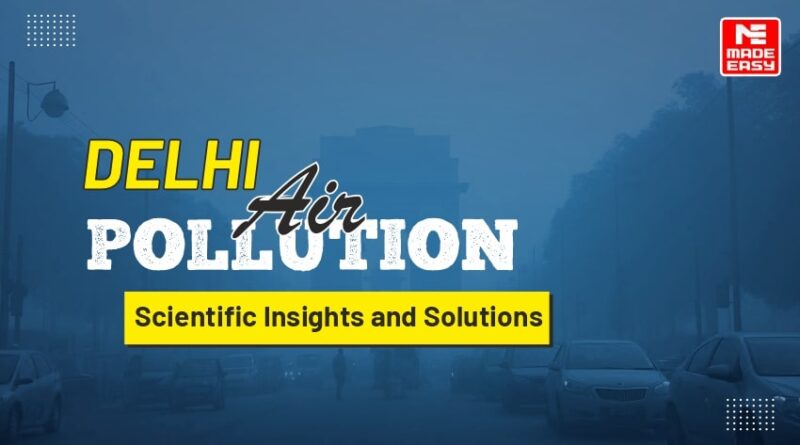Delhi Air Pollution: Scientific Insights and Solutions
Delhi, the capital of India, is vastly known for its history, cultural dances, and variety of food that is like a short festival for your taste buds. The city has attractions like the majestic Red Fort, busy Chandni Chowk, poetic charm of Connaught Place, intellectual hub of the University of Delhi and many more. The city thrives on rich culture and timeless heritage, but nowadays it is hustling under the thick blanket of air pollution. The blog delves into providing scientific insights and solutions for Delhi air pollution.
Brief overview of Delhi’s air pollution crisis
For the past few years, it has been observed that every year from October to November, Delhi-NCR gets engulfed in a thick and unwanted blanket of pollution. And this leads to several environmental concerns leading to low visibility, affecting air quality, harming biodiversity, welcoming water pollution, and many more. However, this crisis is not only an environmental concern; it also alarms public health. The city’s air quality dips to hazardous levels, which affects the daily lives of the citizens. It majorly impacts the respiratory health of people, leading to an increase in cases of asthma, bronchitis, and other chronic respiratory conditions. Along with environmental and health concerns, Delhi Air Pollution also disrupts outdoor activities, reducing workplace productivity, shutting down schools, and burdening the healthcare system.
Table of Contents
Why is it a major environmental and health concern?
Delhi air pollution is primarily due to various sources such as vehicular emissions, industrial activities, and the burning of agricultural stubble. Also, unfavorable weather conditions such as low wind speed and temperature inversion prompt these primary sources to create a toxic air over the region. This toxic air highlights major environmental and health concerns:-
Environmental concerns:
- Decline in the air quality: The oxygen is vital for breathing, and with the increase in air pollution, there is a decline in the air quality.
- Water pollution: The river Yamuna is the most obvious example of this crisis. Industrial water, untreated sewage, and chemical runoff make the river most polluted. One can find toxic white foam that seems like snow in the river, which disrupts ecosystems and water bodies along with causing severe health risks.
- Harming the ecosystem: Polluted air and water have a negative impact on animals, plants, and aquatic environments. As a result, the city’s biodiversity, both within and outside, suffers.
Health concerns:
- Severe for respiratory health: Citizens are exposed to severe respiratory issues such as asthma, bronchitis, and other chronic respiratory diseases. Breathing in polluted air can also cause irritation in the eyes, nose, and throat as well.
- Cardiovascular diseases: With severe respiratory health, Delhi people have increased risk of heart attacks, strokes, and hypertension.
- Major effects on vulnerable populations: Well, Delhi air pollution affects the public; it has a high risk for children, the elderly, and individuals with pre-existing conditions.
- Mental health: Air pollution does affect the respiratory system, heart risk, and more. Experts say that physical health is interconnected with mental health, resulting in an increase in anxiety and depression and reducing cognitive functions.
What is Smog?
As a result of smog, one kind of air pollution, visibility is often reduced in Delhi. Smog is a type of air pollution that’s a combination of smoke, fog, and other pollutants that reduces visibility.
Fog + Smoke = Smog
Pollutants are substances or energy that are introduced into the environment and cause harm or disrupt natural processes. When pollutants such as nitrogen oxides (NOx) and volatile organic compounds (VOCs) react with sunlight, creating ground-level ozone. This is mixed with fine particulate matter present in the surroundings, leading to dense fog in Delhi.
Types of Smog
- Classical Smog/Winter Smog: It is a mixture of smoke, fog, and sulphur dioxide. When there is a high concentration of sulphur dioxide and particulate matter created as a result of fuel combustion. The phenomenon occurs due to temperature inversion, i.e., the layer in the atmosphere in which air temperature increases with height, which is the opposite of what usually happens.
Sulphurous smog or London smog are other names for it. Winter smog covered the city of London for five days, from December 5 to December 9, in 1952. During these five days, the city was covered with dense haze due to temperature inversion and trapping the pollutants, resulting in reducing the visibility to zero levels.
- Photochemical Smog/Summer Smog: Photochemical smog is a mixture of pollutants that are formed when nitrogen oxides and volatile organic compounds (VOCs) react to sunlight, creating a brown haze above cities. It tends to occur more often in the summer, because that is when we have the most sunlight. Photochemical smog is also known as Los Angeles smog or summer smog. This name comes from the city where it was first observed in the 1940s.
Science behind Smog
Formation of Classical smog/winter smog:
Classical smog, also known as winter smog or sulfurous smog, forms under specific conditions involving cold temperatures, high humidity, and pollution from the burning of fossil fuels like coal.
Temperature inversion is one of the main factors in the formation of classical smog. Temperature inversion is the phenomenon in which temperature varies with the change in height; this is one of the reasons for condensation of clouds. In winters, this condensation of clouds occurs near the ground or at the ground and hence is visible as fog.
- The pollutants, particularly sulfur dioxide, mix with the fog.
- SO₂ reacts with water droplets to form sulfuric acid (H₂SO₄) and other sulfates.
- Particulate matter combines with these acidic droplets, making the smog denser and more toxic.
Formation of photochemical smog:
Photochemical smog, often called ‘summer smog,’ is a type of smog that forms when sunlight interacts with primary pollutants like nitrogen oxides and volatile organic compounds. Nitrogen oxides and VOCs are emitted from vehicles and industrial processes.
- Nitrogen dioxide can be broken down by sunlight to form nitric oxide and an oxygen radical.
- Oxygen radicals can then react with atmospheric oxygen to form ozone. Ozone is consumed by nitric oxide to produce nitrogen dioxide and oxygen.
- Harmful products, such as PAN (peroxyacetyl nitrate), are produced by reactions of nitrogen dioxide with various hydrocarbons, which are compounds made from carbon, hydrogen, and other substances.
- The main source of these hydrocarbons are the VOCs. Similarly, oxygenated organic and inorganic compounds react with nitric oxide to produce more nitrogen oxides.
- The significance of the presence of the VOCs in these last two reactions is paramount. Ozone is normally consumed by nitric oxide. However, when VOCs are present, nitric oxide and nitrogen dioxide are consumed, allowing the buildup of ground-level ozone.
Impact of Delhi air pollution on Economy
The acuteness of Delhi air pollution is not a seasonal inconvenience that the public suffers, but it is a serious challenge that impacts the city’s economy and the health of people. Delhi’s geographical location, industrial activities, vehicular emissions, temperature inversion, and stubble burning in the neighboring cities all contribute to this problem.
The air quality index, AQI, of Delhi and NCR hits the ‘severe’ category during the winter season, with PM 2.5 and PM 10 concentrations exceeding safe limits. Experts say India’s worsening air pollution is having a ruinous impact on its economy—with one study estimating losses to the tune of $95 billion annually, or roughly three percent of the country’s GDP. Air pollution costs a lot to Indian businesses due to reduced productivity, work absence, and premature death. Emergency measures are taken such as shutting schools, hampering students’ education and completion of the syllabus, constraining heavy vehicles, reducing goods transportation, temporary banning construction, impacting the livelihood of laborers, and corporates with increased absentees reducing the work productivity, all contributing to significant economic costs.
The Graded Response Action Plan was introduced in 2017 by the Environment Pollution (Prevention and Control) Authority (EPCA) to tackle pollution levels systematically. GRAP categorizes the air quality in different categories—moderate, poor, very poor, severe, and severe +. As the air quality rises to severe + level, GRAP 4 is implemented, in which AQI crosses 450 or reaches the “emergency” level.
Air Quality Index (AQI) and its Implications
The Air Quality Index is a tool that is used to measure the quality of air and the health risks associated with it. The AQI is calculated by the EPA (Environmental Protection Agency) based on five major air pollutants: PM2.5 and PM 10 (fine and coarse particulate matter), ozone, nitrogen dioxide, sulphur dioxide, and carbon monoxide. AQI is categorized into six—good, satisfactory, moderate, poor, very poor, and severe.
In winter, Delhi air quality often ranges between very poor and severe. Its implications are:
- Health risks
- Reduce work productivity
- Disrupting education due to shutdown of schools
- Outdoor activities are affected.
- Loss of business activity
- Increased in healthcare costs
Solutions to tackle Delhi’s Air Pollution
GRAP 4 is an emergency measure to prevent further deterioration of air quality. Although these measures might bring down the air quality and pollution levels, the impact will be limited. Delhi air pollution requires various changes like policy measures, technological intervention, sustainable practices, awareness among people to adapt environmental friendly practices, and many others:
- Promotion of EV vehicles
- Access to LPG
- Stop municipal solid waste burning.
- Reducing the use of coal
- Management of dump sites
- Covering the construction materials at construction sites and demolition sites.
- Burning of crop residue needs to stop.
- Use of CNG vehicles
- Car pooling
- Use of metro
- Avoid outdoor exercise
- Wearing a facemask while going outside
- Plant indoor purifying air plants
- Eating healthy food
- Promotion of environmental awareness to adapt eco-friendly practices.
Conclusion
As said, Delhi air pollution is not a seasonal problem that affects the health of citizens, the economy, and the overall quality of people. It is a complex issue that requires collaborative effort from governments, businesses, health experts, and educational institutions.
Click to Understand the Science of Smog
Frequently Asked Questions (FAQs)
Q. 1. What are the main causes of air pollution in Delhi?
Ans. The main causes of air pollution in Delhi are vehicle emissions, stubble burning, industrial activities, and Delhi’s geographical location.
Q. 2. How does air pollution affect human health in Delhi?
Ans. Cardiovascular problems, skin conditions, difficulty in breathing as well as irritation in eyes, nose, and throat, chronic respiratory issues, heart disease, lung cancer, and even premature deaths are major health risks that affect human health in Delhi’s air pollution.
Q. 3. What is the Air Quality Index (AQI), and how is it measured?
Ans. The Air Quality Index (AQI) is a daily report on air quality that measures how clean or polluted the air is and the potential health effects. The AQI is calculated on five major air pollutants: PM2.5 and PM 10 (fine and coarse particulate matter), ozone, nitrogen dioxide, sulphur dioxide, and carbon monoxide.
Q. 4. What are some personal steps I can take to protect myself from air pollution in Delhi?
Ans. Avoid doing outdoor exercise, wear a mask when going outside, use an air purifier, plant indoor air purifying plants, and eat foods rich in antioxidants, vitamins, and minerals that can help boost your immunity and reduce the harmful effects of air pollution on your body.
Q. 5. How can individuals contribute to reducing air pollution in Delhi?
Ans. Use of CNG vehicles, car pooling, public transport like Delhi metro, use of electric vehicles, avoid burning trash, and others are some measures an individual can do to contribute to reducing air pollution in Delhi.
Dear Aspirants,
Your preparation for GATE, ESE, PSUs, and AE/JE is now smarter than ever — thanks to the MADE EASY YouTube channel.
This is not just a channel, but a complete strategy for success, where you get toppers strategies, PYQ–GTQ discussions, current affairs updates, and important job-related information, all delivered by the country’s best teachers and industry experts.
If you also want to stay one step ahead in the race to success, subscribe to MADE EASY on YouTube and stay connected with us on social media.
MADE EASY — where preparation happens with confidence.

MADE EASY is a well-organized institute, complete in all aspects, and provides quality guidance for both written and personality tests. MADE EASY has produced top-ranked students in ESE, GATE, and various public sector exams. The publishing team regularly writes exam-related blogs based on conversations with the faculty, helping students prepare effectively for their exams.




